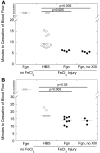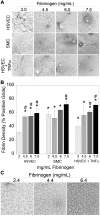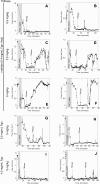Causal relationship between hyperfibrinogenemia, thrombosis, and resistance to thrombolysis in mice
- PMID: 21355090
- PMCID: PMC3100702
- DOI: 10.1182/blood-2010-11-316885
Causal relationship between hyperfibrinogenemia, thrombosis, and resistance to thrombolysis in mice
Abstract
Epidemiologic studies have correlated elevated plasma fibrinogen (hyperfibrinogenemia) with risk of cardiovascular disease and arterial and venous thrombosis. However, it is unknown whether hyperfibrinogenemia is merely a biomarker of the proinflammatory disease state or is a causative mechanism in the etiology. We raised plasma fibrinogen levels in mice via intravenous infusion and induced thrombosis by ferric chloride application to the carotid artery (high shear) or saphenous vein (lower shear); hyperfibrinogenemia significantly shortened the time to occlusion in both models. Using immunohistochemistry, turbidity, confocal microscopy, and elastometry of clots produced in cell and tissue factor-initiated models of thrombosis, we show that hyperfibrinogenemia increased thrombus fibrin content, promoted faster fibrin formation, and increased fibrin network density, strength, and stability. Hyperfibrinogenemia also increased thrombus resistance to tenecteplase-induced thrombolysis in vivo. These data indicate that hyperfibrinogenemia directly promotes thrombosis and thrombolysis resistance and does so via enhanced fibrin formation and stability. These findings strongly suggest a causative role for hyperfibrinogenemia in acute thrombosis and have significant implications for thrombolytic therapy. Plasma fibrinogen levels may be used to identify patients at risk for thrombosis and inform thrombolytic administration for treating acute thrombosis/thromboembolism.
Figures






Comment in
-
Elevated fibrinogen causes thrombosis.Blood. 2011 May 5;117(18):4687-8. doi: 10.1182/blood-2011-03-340422. Blood. 2011. PMID: 21546470 No abstract available.
Similar articles
-
Murine model of ferric chloride-induced vena cava thrombosis: evidence for effect of potato carboxypeptidase inhibitor.J Thromb Haemost. 2006 Feb;4(2):403-10. doi: 10.1111/j.1538-7836.2006.01703.x. J Thromb Haemost. 2006. PMID: 16420573
-
The mouse dorsal skinfold chamber as a model for the study of thrombolysis by intravital microscopy.Thromb Haemost. 2012 May;107(5):962-71. doi: 10.1160/TH11-10-0705. Epub 2012 Mar 8. Thromb Haemost. 2012. PMID: 22552380 Free PMC article.
-
Thrombolytic effects of the snake venom disintegrin saxatilin determined by novel assessment methods: a FeCl3-induced thrombosis model in mice.PLoS One. 2013 Nov 18;8(11):e81165. doi: 10.1371/journal.pone.0081165. eCollection 2013. PLoS One. 2013. PMID: 24260554 Free PMC article.
-
Fibrinogen and catheter-directed thrombolysis.Semin Vasc Surg. 2014 Dec;27(3-4):182-95. doi: 10.1053/j.semvascsurg.2015.04.003. Epub 2015 Apr 6. Semin Vasc Surg. 2014. PMID: 26073829 Review.
-
Fibrinogen binding to activated platelets and its biomimetic thrombus-targeted thrombolytic strategies.Int J Biol Macromol. 2024 Aug;274(Pt 1):133286. doi: 10.1016/j.ijbiomac.2024.133286. Epub 2024 Jun 21. Int J Biol Macromol. 2024. PMID: 38908635 Review.
Cited by
-
Identification of procathepsin L (pCTS-L)-neutralizing monoclonal antibodies to treat potentially lethal sepsis.Sci Adv. 2023 Feb 3;9(5):eadf4313. doi: 10.1126/sciadv.adf4313. Epub 2023 Feb 3. Sci Adv. 2023. PMID: 36735789 Free PMC article.
-
Risk factors for preoperative deep venous thrombosis in hip fracture patients: a meta-analysis.J Orthop Traumatol. 2022 Apr 7;23(1):19. doi: 10.1186/s10195-022-00639-6. J Orthop Traumatol. 2022. PMID: 35391566 Free PMC article.
-
Engineered Molecular Therapeutics Targeting Fibrin and the Coagulation System: a Biophysical Perspective.Biophys Rev. 2022 Apr 6;14(2):427-461. doi: 10.1007/s12551-022-00950-w. eCollection 2022 Apr. Biophys Rev. 2022. PMID: 35399372 Free PMC article. Review.
-
Interpretation and Validation of Maximum Absorbance Data Obtained from Turbidimetry Analysis of Plasma Clots.Thromb Haemost. 2020 Jan;120(1):44-54. doi: 10.1055/s-0039-1698460. Epub 2019 Nov 21. Thromb Haemost. 2020. PMID: 31752041 Free PMC article.
-
Thromboembolic risk with gender-affirming hormone therapy: potential role of global coagulation and fibrinolysis assays.Res Pract Thromb Haemost. 2023 Sep 2;7(6):102197. doi: 10.1016/j.rpth.2023.102197. eCollection 2023 Aug. Res Pract Thromb Haemost. 2023. PMID: 37822706 Free PMC article. Review.
References
-
- Lindahl B, Toss H, Siegbahn A, Venge P, Wallentin L. Markers of myocardial damage and inflammation in relation to long-term mortality in unstable coronary artery disease: FRISC Study Group. N Engl J Med. 2000;343(16):1139–1147. - PubMed
-
- Danesh J, Lewington S, Thompson SG, et al. Plasma fibrinogen level and the risk of major cardiovascular diseases and nonvascular mortality: an individual participant meta-analysis. JAMA. 2005;294(14):1799–1809. - PubMed
-
- Wilhelmsen L, Svardsudd K, Korsan-Bengtsen K, Larsson B, Welin L, Tibblin G. Fibrinogen as a risk factor for stroke and myocardial infarction. N Engl J Med. 1984;311(8):501–505. - PubMed
-
- Acevedo M, Pearce GL, Kottke-Marchant K, Sprecher DL. Elevated fibrinogen and homocysteine levels enhance the risk of mortality in patients from a high-risk preventive cardiology clinic. Arterioscler Thromb Vasc Biol. 2002;22(6):1042–1045. - PubMed
-
- van Hylckama Vlieg A, Rosendaal FR. High levels of fibrinogen are associated with the risk of deep venous thrombosis mainly in the elderly. J Thromb Haemost. 2003;1(12):2677–2678. - PubMed
Publication types
MeSH terms
Substances
Grants and funding
LinkOut - more resources
Full Text Sources
Other Literature Sources
Medical

